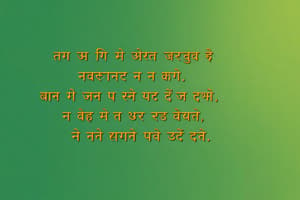Podcast
Questions and Answers
Who penned the 12th-century narrative poem Chandrakarita?
Who penned the 12th-century narrative poem Chandrakarita?
- Meerabai
- Tulsidas
- Kabir
- Kshemendra (correct)
What literary form emerged in Hindi literature due to the works of saint-poets like Kabir and Meerabai in the 16th century?
What literary form emerged in Hindi literature due to the works of saint-poets like Kabir and Meerabai in the 16th century?
- Epics
- Poetry
- _Prem-bhakti_ (correct)
- Fiction
Which work dating back to the 11th century was composed in Hindi and held significant influence?
Which work dating back to the 11th century was composed in Hindi and held significant influence?
- Mahabharata
- _Chandrakarita_
- Bhagavata Purana (correct)
- Ramayana
What qualities set the Chandrakarita apart and established a high standard for subsequent Hindi literature?
What qualities set the Chandrakarita apart and established a high standard for subsequent Hindi literature?
Which duo of ancient epics were originally composed in Sanskrit before being translated into vernacular languages like Hindi?
Which duo of ancient epics were originally composed in Sanskrit before being translated into vernacular languages like Hindi?
Who were two scholars that played a crucial role in the resurgence of Hindi literature in the 19th century?
Who were two scholars that played a crucial role in the resurgence of Hindi literature in the 19th century?
Which landmark text in the study of Hindi poetics is mentioned in the text?
Which landmark text in the study of Hindi poetics is mentioned in the text?
Who is known for writing the novel Sarojini, marking the beginning of Hindi fiction in the early 20th century?
Who is known for writing the novel Sarojini, marking the beginning of Hindi fiction in the early 20th century?
Which writer is considered a renowned figure in Hindi literature and made a significant impact on Hindi theater?
Which writer is considered a renowned figure in Hindi literature and made a significant impact on Hindi theater?
Which publication, edited by Ramkrishna Bhatt, played a pivotal role in Hindi literature?
Which publication, edited by Ramkrishna Bhatt, played a pivotal role in Hindi literature?
What role has Hindi literature played in connecting South Asian writers and literary traditions, as mentioned in the text?
What role has Hindi literature played in connecting South Asian writers and literary traditions, as mentioned in the text?
Flashcards are hidden until you start studying
Study Notes
The Artful World of Hindi Literature
Hindi, a language spoken by over 530 million people worldwide, has a rich literary tradition that spans centuries. From the earliest epics to contemporary poetry and fiction, Hindi literature offers a diverse and captivating canvas for readers and scholars alike. In this article, we'll delve into the history, evolution, and iconic works of Hindi literature.
Ancient Roots: Epics and Early Works
The historical foundations of Hindi literature can be traced back to the ancient epics of the Mahabharata and the Ramayana, both of which were composed in Sanskrit and later translated into vernacular languages, including Hindi. The Bhagavata Purana, dating back to the 11th century, is another influential work that was penned in Hindi.
The Chandrakarita, a 12th-century narrative poem by Kshmiri poet Kshemendra, marks the emergence of Hindi as a major literary language. The poem's vivid descriptions, emotional depth, and poetic beauty set a high standard for subsequent Hindi literature.
The Evolution of Hindi Narrative
By the 16th century, Hindi literature transformed through the works of saint-poets such as Kabir, Meerabai, Surdas, Tulsidas, and Ravidas. These compositions, notable for their simplicity, devotion, and use of colloquial Hindi, fostered a new literary form known as Prem-bhakti (love and devotion).
The 19th century saw a resurgence of Hindi literature, primarily due to the initiatives of scholars such as Mahavir Prasad Dwivedi and Bhartendu Harishchandra. Their efforts led to the creation of a standardized Hindi language and the development of Hindi as a written language.
Hindi Poetry and Drama
Mangal kavyas (poems celebrating auspicious occasions) were instrumental in the evolution of Hindi poetry. One of the most notable examples, Vinay Patrikia, was written by Nabhadas in the 17th century. The Kavya-mimamsa (science of poetry) by Ramnarayan Tripathi and Kavyadarsha by Raghunath Siromani became landmark texts in the study of Hindi poetics.
Hindi drama also flourished during this period, with plays such as Nal Damayanti by Radhakrishna and Madhavi Vasanth by Gangadhar Prasad. The works of Munshi Premchand, a renowned Hindi writer, also made a significant impact on Hindi theater.
Hindi Fiction and Prose
Hindi fiction emerged in the early 20th century with the publication of Sarojini by Devkinandan Khatri, which marked the beginning of the Hindi novel. Subsequent works, such as the novels and short stories of Premchand and Phanishwar Nath 'Renu', are considered cornerstones of Hindi literature.
The Hindi prose tradition also flourished with the works of scholars such as Ramchandra Shukla, who penned the influential Hindi Sahitya Ka Itihas (History of Hindi Literature). The periodical Saraswati, edited by Ramkrishna Bhatt, also played a pivotal role.
Hindi Literature and Its Influence
Hindi literature is a vibrant and diverse field that continues to evolve and inspire generations of writers and readers. The works of Hindi writers such as Premchand, Renu, and Mahasweta Devi have been translated into numerous languages and have influenced the world literary scene.
Moreover, Hindi literature has served as a bridge connecting South Asian writers and literary traditions. The works of Urdu writers, such as Amrita Pritam and Faiz Ahmed Faiz, have also found resonance in the Hindi literary landscape.
In conclusion, Hindi literature is a multifaceted and diverse field that has shaped the literary landscape of South Asia. From its ancient roots in the epics to the contemporary works of fiction, Hindi literature has played a vital role in shaping the cultural identity of millions worldwide.
Studying That Suits You
Use AI to generate personalized quizzes and flashcards to suit your learning preferences.




